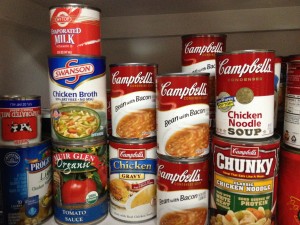 It’s a smart idea to buy large quantities of food and other necessities when they are on sale. You can store these items and use them over several months. Eventually, you’ll have a whole room full of items that were purchased on sale— food, health and beauty aids, storage bags, cleaning supplies, and even toilet paper. When you need food or household items, you get them from your storage room rather than going to the store and paying full retail prices. (For a complete plan on how to do this, see chapter 1 of the book Talk About Saving Money: How to Save on Food, Utilities, Car Expenses, Mortgage, and Health Care. Sign up for the free newsletter on this site and get a free digital copy of the book.)
It’s a smart idea to buy large quantities of food and other necessities when they are on sale. You can store these items and use them over several months. Eventually, you’ll have a whole room full of items that were purchased on sale— food, health and beauty aids, storage bags, cleaning supplies, and even toilet paper. When you need food or household items, you get them from your storage room rather than going to the store and paying full retail prices. (For a complete plan on how to do this, see chapter 1 of the book Talk About Saving Money: How to Save on Food, Utilities, Car Expenses, Mortgage, and Health Care. Sign up for the free newsletter on this site and get a free digital copy of the book.)
Rotation
It is important to rotate the items you buy so you use the older items first. Put the newer items in the back so you use items on a first-in-first-out basis. For water and other items without dates, be sure to write a date on the container so you know when it’s time to replace it. Buying bottled water for drinking is a good idea.
Expiration Dates
There are two kinds of expiration dates on food, which refer to the quality of the food, and not necessarily the safety of the food.
- Sell By: This date tells the store how long to display the product for sale. This is a guide for the retailer to know when to pull it from the shelves. It represents the last day the food is at its peak quality of freshness, taste, and consistency. It is still safe to eat after this date. Milk will usually go bad about a week after the Sell By date, while eggs are okay for 3-5 weeks after the date. Poultry and seafood should be cooked or frozen within a day or two. Cook or freeze beef or pork within 3-5 days.
- Use By or Best If Used By: This date refers to when the quality of the item starts to go downhill. It is still safe to eat after this date, but in some cases, you may notice a difference in taste or consistency after that date. For example, sour cream may become a little more sour or peanut butter may begin to separate in the jar.
Below is a table with the USDA’s recommendations. See the USDA website for more foods:
Refrigerator Storage of Fresh or Uncooked Products (Storage Times After Purchase):
- Poultry: 1-2 days
- Beef, Veal, Pork, Lamb: 3-5 days
- Ground Meat and Ground Poultry: 1-2 days
- Cured Ham, Cook-Before-Eating: 5-7 days
- Sausage from Pork, Beef or Turkey, Uncooked: 1-2 days
- Eggs: 3-5 weeks
Once a perishable product is frozen, it doesn’t matter if the date expires because foods kept frozen continuously are safe indefinitely, although they may get freezer burned after a time.
Canned foods:
- Highly acidic foods (like tomato sauce) can be keep 18 months or more.
- Low-acid foods (like canned green beans) are probably risk-free for up to five years.
- Bulging cans are a sign of bacteria growth and should be discarded, no matter what the expiration date.
Bread: Safe to eat until any mold appears. Even if one piece of bread develops mold, throw out the entire package because the mold spores will have spread to the entire loaf.
Cheese: With age, cheeses become sharper, but the food value and safety is not compromised. If mold grows on shredded cheese and soft cheeses (such as cottage cheese and cream cheese), they should be discarded. However, mold generally can’t penetrate far into hard and semisoft cheeses, such as Cheddar, Colby and Swiss, so you can cut off at least one inch around and below the moldy spot and eat the rest of the cheese.
Medicines and vitamins: After the expiration date, some decrease in potency and some become more potent. So it’s safest to discard them.
Bottled water: The FDA considers bottled water to have an indefinite shelf life if it’s produced in accordance with regulations and remains unopened. Expiration dates are voluntary and may reflect concerns about taste and odor rather than safety. Store bottled water in a cool location away from direct sunlight.
These websites have additional information on expiration dates: WebMD and USDA.



